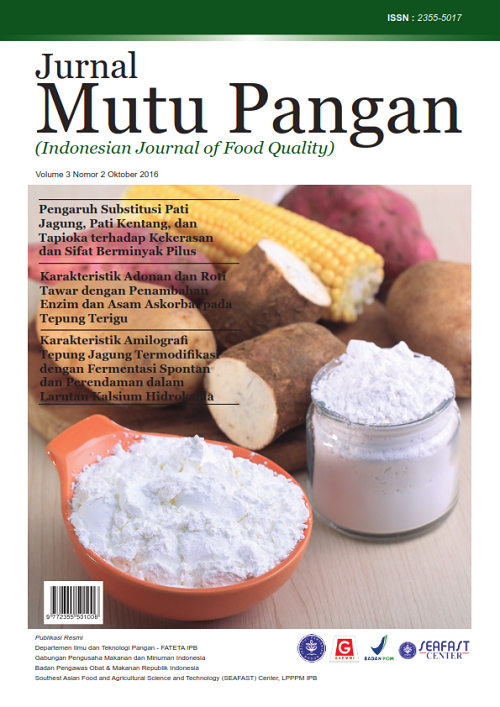Karakteristik Adonan dan Roti Tawar dengan Penambahan Enzim dan Asam Askorbat pada Tepung Terigu
Abstract
Wheat flour containing a 33-39% wet gluten is commonly applied in pan bread processing, however, it is expensive. The use of wheat flour containing a lower wet gluten yields a lower quality bread. This objective of this research was to produce acceptable quality pan bread using enzyme-treated wheat flour containing medium wet gluten content (31.8%). Wheat flour was treated by adding enzymes and ascorbic acid. The combination of enzymes (30 ppm α-amylase, 26 ppm α-glucosidase, 16 ppm xylanase), and 40 ppm ascorbic acid yielded dough resistancy and extensibility as well as the bread qua-lity that miccked those made of high wet gluten wheat flour (35.0%).Downloads
References
[AACC] American Association of Cereal Chemists. 2000. Approved Methods of The American Association of Cerial Chemists 10th Edition. St. Paul (US): AACC International
Baratto CM, Becker NB, Gelinski JMLN, Silveira SM. 2015. Influence of enzymes and ascorbic acid on dough rheology and wheat bread quality. Afr J Biotech 14(46): 3124-3130. DOI: 10.5897/AJB 2015. 14931
Bonet A, Rosell CM, Perez-Munuera I, Hernando I. 2007. Rebuilding gluten network of damaged wheat by means of glucose oxidase treatment. J Sci Food Agr 87(7): 1301-1307. DOI: 10.1002/jsfa.2846.
Brown A. 2015. Understanding Food Principles and Pre-paration. Stamford (US): Cengage Learning.
Codina GG. 2008. Effects of different doses of ascorbic acid on alveograph and bread making quality of wheat flour with average quality as starting material. JAPT 14: 87-92.
Codina GG, Leahu A. 2009. The improvement of the qua-lity of wheat flour with a lower content of α-amylase through the addition of different enzymatic products. Lucrari Stiintifice seria Agr 52: 629-635.
Courtin CM, Delcour JA. 2001. Relative activity of endo-xylanases towards water extractable and water-unex-tractable arabinoxylan. J Cereal Sci 33(3): 301-312. DOI: 10.1006/jcrs.2000.0354.
Dua S, Lukow OM, Humphreys G, Adams K. 2009. Effect of extraction methods and wheat cultivars on gluten functionality. Open Food Sci J 3: 84-92. DOI: 10. 2174/1874256400903010084.
Gisslen W. 2009. Professional Baking: Fifth Edition. New Jersey (CN): John Wiley & Sons, Inc.
Haarasilta S, Pullinen T. 1992. Novel enzyme combination: A new tool to improve baking results. Agro-Food Industry Hi-Tech 3: 12-13.
Hruskova M, Novotna D. 2003. Effect of ascorbic acid on the rheological properties of wheat fermented dough. Czech J Food Sci 21(4): 137-144.
Maloney DH, Foy JJ. 2003. Yeast Fermentations in K.pulp & K.lorenz (Eds). Handbook of Dough Fermentation. Boca Raton: CRC Press.
Mudjisihono R. 1994. Studi pembuatan roti campuran tepung jagung dan sorgum. J Ilmu Pertanian Indonesia 4(1): 16-22.
Mudjajanto ES, Yulianti LN. 2010. Membuat Aneka Roti. Jakarta (ID): Penebar Swadaya.
Rasiah IA, Suttom KH, Low FL, Lin HM, Gerrard JA. 2005. Cross-linking of wheat dough protein by glucose oxidase and resulting effects on bread and croissants. Food Chem J 89: 325-332.
Saliem HP, Reni K. 2010. Situation and trends of wheat flour consumption in Indonesia: Analysis of Susenas food consumption data (1996-2008). Departemen Per-tanian Indonesia. Jakarta (ID).
Shewry P.R, Tathan A.S. (2000). Wheat Gluten. Th Royal Society of Chemistry, Cambridge, UK: 271-282
Sollner LS. 2016. How to Deal with Changing Flour Quality. AIB International School of Baking. USA.
Steffolani ME, Ribotta PD, Perez GT, Leon AE. 2012. Combinations of glucose oxidase, α-amylase and xyla-nase affect dough properties and bread quality. J Food Sci and Tech 47(3): 525-534. DOI: 10.1111/ j.1365-2621.2011.02873.x
Vemulapalli V, Miller KA, Hoseney RC. 1998. Glucose oxidase in breadmaking systems. Cereal Chem 75: 439-442.
Wassermann L. 2009. Bread Improvers–Action and Appli-cation. Geschaftsbereich (GE): Wissensforum Back-waren e.V.
[WMC] Wheat Marketing Center. 2007. Wheat and Flour Testing Methods: a Guide to Understanding Wheat and Flour Quality. Oregon (US): North American Export Grain Association.

















